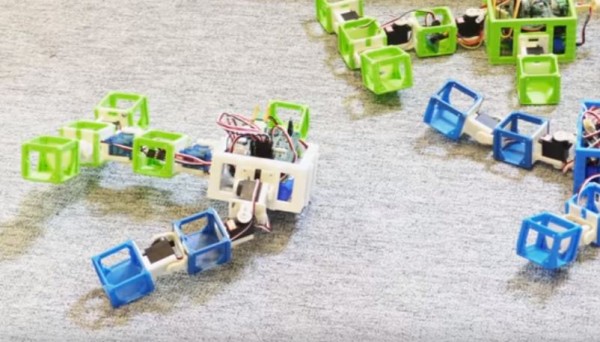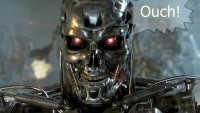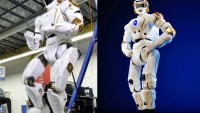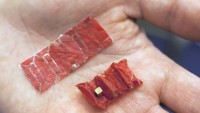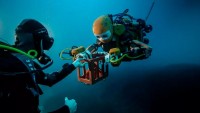World’s First ‘Robot Baby’ is Born and Yes, Its Parents had ‘Robot Sex’
| Arthur Dominic Villasanta | | Jun 01, 2016 08:41 AM EDT |
(Photo : Vrije Universiteit Amsterdam ) The world's first robot baby (left) and its parents
Robot sex was bound to happen and it has. The result: the "birth" of the world's first robot baby. A team of Dutch scientists at the Vrije Universiteit Amsterdam said they've built the world's first "robots that procreate."
It doesn't mean what you're think and isn't sex the way humans understand it. But this successful process of robot "dating," robot "sex" and robot "birth" is seen by the research team as the first step towards creating robotic ecosystems that evolve in challenging environments, meaning robots that get better with each generation born.
Like Us on Facebook
Prof. Dr. A.E. Eiben, a professor of Computational Intelligence at the VU University Amsterdam and project team leader, said the world's first "robot baby" was born on Feb. 19, 2016 in a laboratory at the university. And why is this event historic?
"For science, that means artificial evolution can break out of computer simulations and enter the real world," said Eiben. Scary.
The baby was first presented to the public on May 26 at the Jaarbeurs, an exhibition and convention centre in Utrecht. Robot sex or mating was also demoed at this event.
The historic first robot baby is an ugly creature. It's a collection of hollow plastic squares with a torso, two hands and two feet.
The square blocks in the robot baby, which wasn't given a name, are colored green and blue. These colors are significant because it shows the DNA of its parents was passed on to the baby.
One of the baby's parents is all blue; the other, all green.
The team said this breakthrough birth is a significant first step in the "Industrial Evolution" and can play an important role in the colonization of Mars, for example.
The sex part isn't that important. What is groundbreaking is the finding that in addition to developing their brains by learning, robots can now develop their bodies through evolution.
"Because robot parents select suitable mating partners with certain desirable properties, successive generations can improve their physical form and behavior, adjusting these to their environment and the task they have to perform," reported the team.
"This makes them suitable for locations where the circumstances are unknown in advance, such as mines in deep seas or other planets."
Eiben and his team completed a proof-of-concept and built physical robots that have their own 'DNA' and can produce children via a 3D printer (or the delivery room doctor). During robot reproduction, the features of the parents are randomly recombined, including the software (the brain) and hardware (the body).
After "birth," the newborn robot undergoes a learning process. If it survives, it becomes an adult and can become a parent itself.
Eiben said this breakthrough marks the beginning of a new era that he calls the "Industrial Evolution." Here, machines that autonomously operate and reproduce are no longer science fiction.
"Evolution is a great designer," said Eiben.
"The Evolution of Things is an emerging new technology that exploits the power of selection and reproduction to breed robot designs that are hard to obtain by traditional approaches. Robots that evolve can adapt to their environment and cope with unforeseen situations.
"The bodies, brains, and behaviors are continually tested by the environment and the useful traits are amplified in future generations. This technology opens new perspectives for robotics, artificial intelligence, space research, and even biology."
A video of the robot baby can be seen on YouTube here.
Tagsrobot sex, Vrije Universiteit Amsterdam, Prof. Dr. A.E. Eiben, Industrial Evolution
©2015 Chinatopix All rights reserved. Do not reproduce without permission
EDITOR'S PICKS
-

Did the Trump administration just announce plans for a trade war with ‘hostile’ China and Russia?
-

US Senate passes Taiwan travel bill slammed by China
-

As Yan Sihong’s family grieves, here are other Chinese students who went missing abroad. Some have never been found
-

Beijing blasts Western critics who ‘smear China’ with the term sharp power
-

China Envoy Seeks to Defuse Tensions With U.S. as a Trade War Brews
-

Singapore's Deputy PM Provides Bitcoin Vote of Confidence Amid China's Blanket Bans
-

China warns investors over risks in overseas virtual currency trading
-

Chinese government most trustworthy: survey
-

Kashima Antlers On Course For Back-To-Back Titles
MOST POPULAR
LATEST NEWS
Zhou Yongkang: China's Former Security Chief Sentenced to Life in Prison

China's former Chief of the Ministry of Public Security, Zhou Yongkang, has been given a life sentence after he was found guilty of abusing his office, bribery and deliberately ... Full Article
TRENDING STORY

China Pork Prices Expected to Stabilize As The Supplies Recover

Elephone P9000 Smartphone is now on Sale on Amazon India

There's a Big Chance Cliffhangers Won't Still Be Resolved When Grey's Anatomy Season 13 Returns

Supreme Court Ruled on Samsung vs Apple Dispute for Patent Infringement

Microsoft Surface Pro 5 Rumors and Release Date: What is the Latest?
